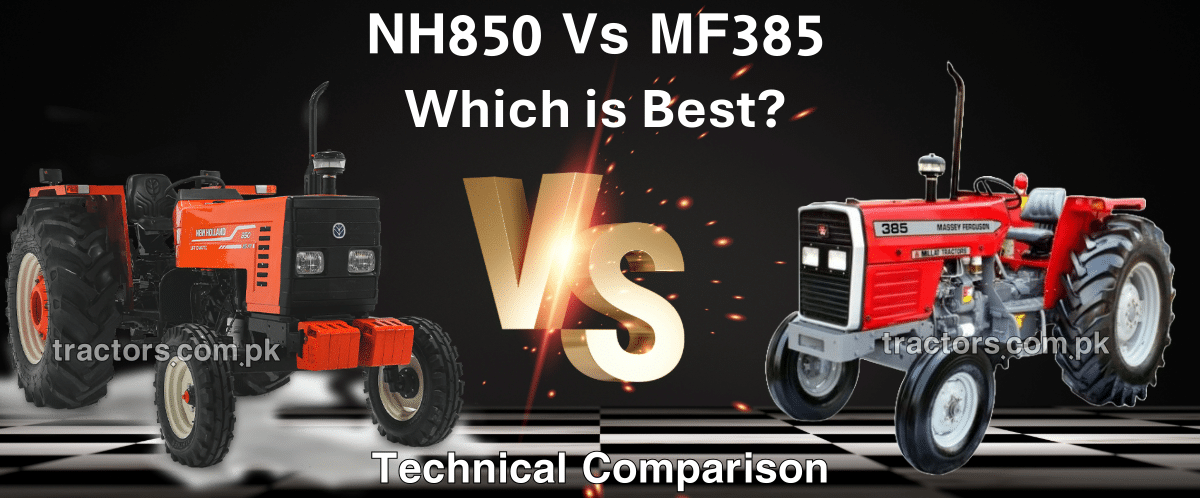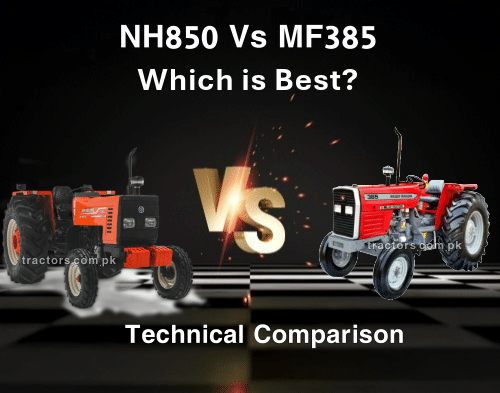Farming is easier when your tractor is strong, reliable, and easy to use. Two favorites in Pakistan are the Massey Ferguson MF 385 and the New Holland NH 850. MF385 Vs NH850 both give you the same 85‑horsepower punch, but they shine in different ways. The MF 385 is known for its tough pull and sturdy hydraulic system, while the NH 850 offers smoother gear shifts, can lift heavier tools, and has a few extra modern features. Let’s look at how they stack up so you can choose the one that fits your fields and the way you work. Both machines are known for their durability, strong performance, and suitability for a variety of farming tasks. But how do they really stack up against each other? Let’s break it down and see which one might be the right fit for your farm.
Check: CM Punjab Green Tractor Scheme Phase 2 – 2025

MF385 Vs NH850 Technical Specifications Comparison
| Category | MF 385 | NH 850 |
|---|---|---|
| Engine type / capacity | 4‑cyl. diesel, 4.41 L | 4‑cyl. diesel, 3.9 L |
| Engine oil sump capacity | 7.5 Liters | 11.5 Liters |
| Aspiration / compression | Natural, 15.3 : 1 | Natural, 17 : 1 |
| Rated power (hp @ rpm) | 85 hp @ 2 200 rpm | 85 hp @ 2 500 rpm |
| Max torque (Nm @ rpm) | 300 Nm @ 1 600 rpm | 291 Nm @ 1 600 rpm |
| Transmission | Sliding‑spur, 8 F / 2 R | Constant‑mesh, 8 F / 2 R |
| Top forward speed | 31 km/h | 33.9 km/h |
| Clutch type | Dual, dry (cerametallic) | Dual, dry (ceramic) |
| PTO | Live, 540 rpm @ 1 789 eng rpm | 540 rpm (hand‑lever control) |
| Hydraulic System | Draft Control, Position control | Liftomatic, Draft Control, Position Control, Float Control, Precision Control |
| Hydraulic pump | Ferguson (piston) | Fiat gear pump |
| Lift capacity (lower links horiz.) | 2145 kg | 2626 kg (standard) / 2854 kg (with Lift‑O‑Matic) |
| Steering | Hydrostatic power | Hydrostatic power |
| Operating weight (approx.) | 2360 kg (with fluids) | 2865 kg (with ballast) |
| Wheelbase | 2286 mm | 2320 mm |
| Transmission & Hydraulic Oil | 38 Liters | 32 Liters |
| Fuel tank | 108 L | 65 L |
| Electrical system | 12 V, 118 Ah batt., 45 A alt. | 12 V, 110/120 Ah batt., 40 A alt. |
| Front / rear tyres | 7.50‑16 • 18.4/15‑30 | 7.50‑16 • 18.4/15‑30 |
Check price of MF385 and NH850
Engine Performance
MF 385 with a 4.41L diesel engine, it delivers 85 hp at 2,200 rpm and a torque of 300 Nm at 1,600 rpm. The engine is naturally aspirated and has a 15.3:1 compression ratio, which means it’s designed to give you steady power in tough conditions. Only drawback is that it has only 7.5 liters engine oil capacity.
NH 850 is a beast when it comes to raw power. It brings a 3.9L engine that also outputs 85 hp at 2,500 rpm with a torque of 291 Nm at 1,600 rpm. It shares the same naturally aspirated design but with a slightly higher 17:1 compression ratio.
Verdict: Both tractors offer equal horsepower, but NH 850 wins with higher engine oil capacity and power, which can be beneficial for heavy pulling.
Transmission & Gears
-
MF 385 offers a sliding spur transmission with 8 forward and 2 reverse gears, giving speeds up to 31 km/h.
-
NH 850 features a constant mesh gearbox, also with 8 forward and 2 reverse gears, maxing out at 33.9 km/h.
Verdict: The NH 850 has a slight edge in max speed and smoother gear shifting due to constant mesh, but both offer similar versatility.
Clutch & PTO
-
The MF 385 has a dual, dry-type cerametallic clutch.
-
The NH 850 also features a dual-plate dry clutch, using ceramic lining, with independent controls for transmission and PTO.
Both tractors offer 540 RPM PTO, but MF 385 hits that at 1,789 engine rpm, whereas NH 850 uses a standard setting.
Verdict: Pretty even, but NH 850 gives more flexibility with its separate PTO hand lever.
Hydraulics System & Lifting Power MF385 Vs NH850
-
MF 385 uses the famous Ferguson pump, offering 2,145 kg lift capacity. Gives options
-
NH 850, with its gear-driven Fiat pump, lifts up to 2,854 kg (with Lift-O-Matic), making it more suitable for heavier implements. Liftomatic hydraulic system is advance and beneficial for precision farming.
Verdict: NH 850 clearly dominates here with advance Italian Liftomatic and with higher lifting power.
Steering & Handling
-
Both tractors are equipped with hydrostatic power steering, ensuring smooth maneuvering.
-
Track adjustability are similar on both, with NH 850 offering 6 adjustable tracks from 1,412 mm to 2,012 mm. NH 850 is designed with symmetrical steering angle to reduce turning radius on both sides. With equal 45 degrees angle on both ends it ensures turning around small corners easily during operations.
Weight & Dimensions
-
MF 385 weighs in at 2,360 kg.
-
NH 850 is heavier, at 2,865 kg with ballast, adding extra grip in the field.
Both tractors are similarly sized, though NH 850 is slightly longer and higher due to its design and ballast configuration.
Electrics & Instrumentation
-
MF 385: 12V, 118Ah battery, 2.8kW starter, 45A alternator.
-
NH 850: 12V, 110/120Ah battery, 3kW starter, 40A alternator.
Instrumentation on both covers essentials like fuel, temperature, and engine status. NH 850 also offers warning lights for battery charge, oil pressure, and turn signals — plus a mobile charging port.
Final Thoughts on MF385 Vs NH850: Which One Should You Choose?
✅ Go with the MF 385 if:
-
You prefer a tractor with haulage.
-
You want a simpler, robust, and proven mechanical setup.
-
You’re looking for solid all-round performance in a slightly lighter machine.
✅ Choose the NH 850 if:
-
You need more engine power.
-
Better engine cooling system.
-
You need more lifting capacity and advanced hydraulics system.
-
You need more efficiency on working with implements.
- If you want less fuel consumption.
-
You want smoother gear shifts and more speed.
-
You prefer a more modern dash with extra indicators and a mobile charging port.
MF385 Vs NH850 both tractors are excellent choices and trusted across countless farms. Your decision will likely come down to your specific field conditions and farming needs. Either way, you’re in for a reliable ride!
Download the original Technical specification brochure of NH 850 technical brochure and MF 385 tractors.


Leave a Reply